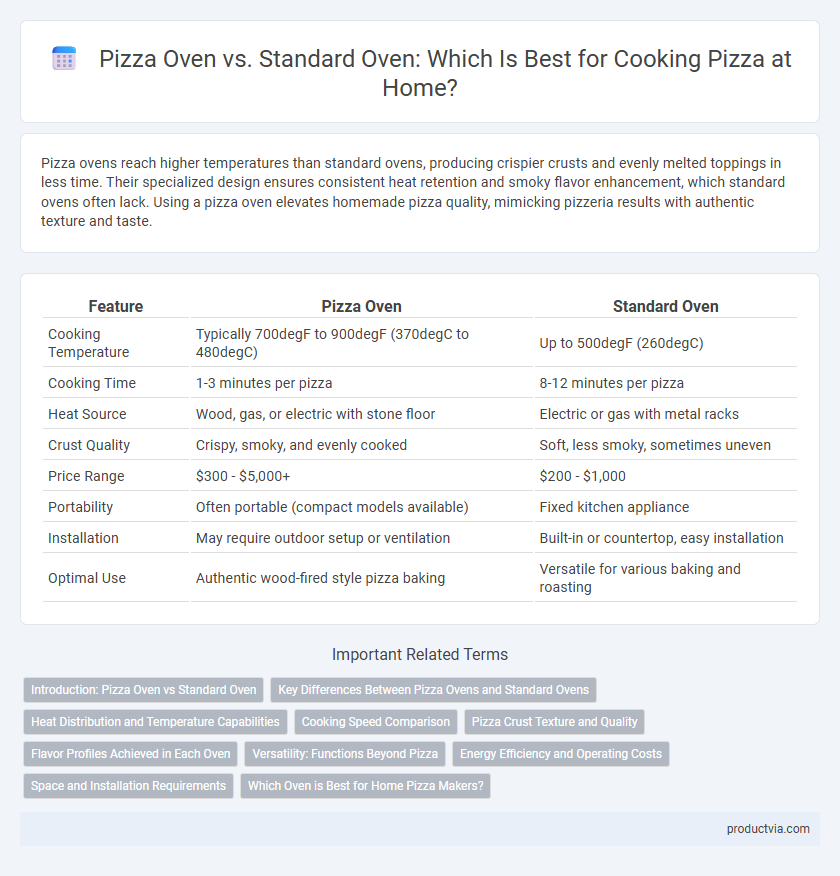Pizza ovens reach higher temperatures than standard ovens, producing crispier crusts and evenly melted toppings in less time. Their specialized design ensures consistent heat retention and smoky flavor enhancement, which standard ovens often lack. Using a pizza oven elevates homemade pizza quality, mimicking pizzeria results with authentic texture and taste.
Table of Comparison
| Feature | Pizza Oven | Standard Oven |
|---|---|---|
| Cooking Temperature | Typically 700degF to 900degF (370degC to 480degC) | Up to 500degF (260degC) |
| Cooking Time | 1-3 minutes per pizza | 8-12 minutes per pizza |
| Heat Source | Wood, gas, or electric with stone floor | Electric or gas with metal racks |
| Crust Quality | Crispy, smoky, and evenly cooked | Soft, less smoky, sometimes uneven |
| Price Range | $300 - $5,000+ | $200 - $1,000 |
| Portability | Often portable (compact models available) | Fixed kitchen appliance |
| Installation | May require outdoor setup or ventilation | Built-in or countertop, easy installation |
| Optimal Use | Authentic wood-fired style pizza baking | Versatile for various baking and roasting |
Introduction: Pizza Oven vs Standard Oven
Pizza ovens differ significantly from standard ovens in temperature capacity, often reaching up to 900degF, enabling faster cooking and crispier crusts. Standard ovens typically max out around 500degF, which can result in longer baking times and less authentic texture. The construction of pizza ovens, such as wood-fired brick designs, also contributes to unique heat retention and flavor development compared to conventional home ovens.
Key Differences Between Pizza Ovens and Standard Ovens
Pizza ovens achieve higher temperatures, often between 700degF to 900degF, compared to standard ovens that typically max out around 500degF, resulting in faster cooking times and crispier crusts. The heat distribution in pizza ovens is more uniform, often using stone or brick, which mimics traditional wood-fired pizza baking and enhances flavor and texture. Standard ovens offer versatility for various dishes but lack the intense, focused heat and specialized design required for authentic, pizzeria-quality pizzas.
Heat Distribution and Temperature Capabilities
Pizza ovens excel in heat distribution by utilizing stone or brick materials that retain and radiate high, consistent heat, enabling optimal pizza crust crispness and even cooking. Standard ovens typically reach lower maximum temperatures, usually up to 500degF (260degC), while pizza ovens can exceed 900degF (482degC), allowing for faster cooking times and a more authentic wood-fired taste. The advanced heat retention and higher temperatures of pizza ovens provide superior results compared to conventional ovens for baking traditional-style pizzas.
Cooking Speed Comparison
Pizza ovens heat up to temperatures between 700degF and 900degF, enabling pizzas to cook in just 2 to 5 minutes, compared to standard ovens that typically reach 450degF to 500degF and require 10 to 15 minutes for similar results. The higher temperature and specialized design of pizza ovens create an intense, evenly distributed heat that crisps the crust quickly while preserving toppings. Standard ovens lack the rapid heat recovery and floor temperature of pizza ovens, resulting in slower cooking times and less authentic crust texture.
Pizza Crust Texture and Quality
Pizza ovens reach higher temperatures, typically between 700degF and 900degF, which allows the pizza crust to cook quickly and develop a crisp, airy texture with a characteristic leopard spotting. Standard ovens usually max out around 500degF, producing a denser crust with less crispness and a chewier consistency due to slower cooking times and lower heat intensity. The intense radiant heat and stone surface in pizza ovens promote superior crust quality by evenly distributing heat and drawing moisture away, resulting in better texture and flavor development.
Flavor Profiles Achieved in Each Oven
Pizza ovens, especially wood-fired models, generate intense, high heat that produces a distinctive smoky flavor and perfectly crisp crust, enhancing the overall taste complexity. Standard ovens offer more moderate, even heat, resulting in a softer crust and less pronounced smoky notes but allow for greater control over cooking times and temperature consistency. The flavor profile from a pizza oven is typically more robust and traditional, while a standard oven yields a milder, more uniform baking result.
Versatility: Functions Beyond Pizza
Pizza ovens excel in high-temperature cooking, delivering a crispy crust and perfect melt for authentic pizzas, but standard ovens offer greater versatility with adjustable temperature ranges and multiple cooking modes suitable for roasting, baking, and broiling a wide variety of dishes beyond pizza. Standard ovens feature built-in timers, convection settings, and temperature control precision, enabling users to prepare complex meals such as casseroles, baked goods, and roasted meats. While pizza ovens specialize in rapid, high-heat performance, standard ovens provide comprehensive functionality for everyday cooking needs.
Energy Efficiency and Operating Costs
Pizza ovens are designed for high-temperature cooking, allowing faster baking times that significantly reduce energy consumption compared to standard ovens. Standard ovens often require longer preheating and cooking durations, leading to higher operating costs and increased energy use. Specialized insulation and heat retention in pizza ovens enhance energy efficiency, making them cost-effective choices for frequent pizza cooking.
Space and Installation Requirements
Pizza ovens typically require more dedicated space and specialized installation compared to standard ovens, often necessitating outdoor placement and ventilation systems. Standard ovens, being built into kitchen cabinetry or freestanding units, offer more compact installation options suitable for indoor use. The choice depends on available space, with pizza ovens demanding larger areas and custom setups to achieve optimal cooking performance.
Which Oven is Best for Home Pizza Makers?
Pizza ovens reach higher temperatures, typically between 700degF and 900degF, allowing for faster cooking times and achieving the authentic crispy crust and perfectly melted cheese classic to pizzeria-quality pizza. Standard ovens usually max out around 500degF, which can result in longer cooking times and less even heat distribution, making it harder to replicate traditional Neapolitan pizza texture. For home pizza makers seeking professional-quality results, a dedicated pizza oven offers superior control and heat intensity, enhancing flavor and texture that standard ovens often cannot match.
Pizza oven vs Standard oven for pizza cooking Infographic

 productvia.com
productvia.com